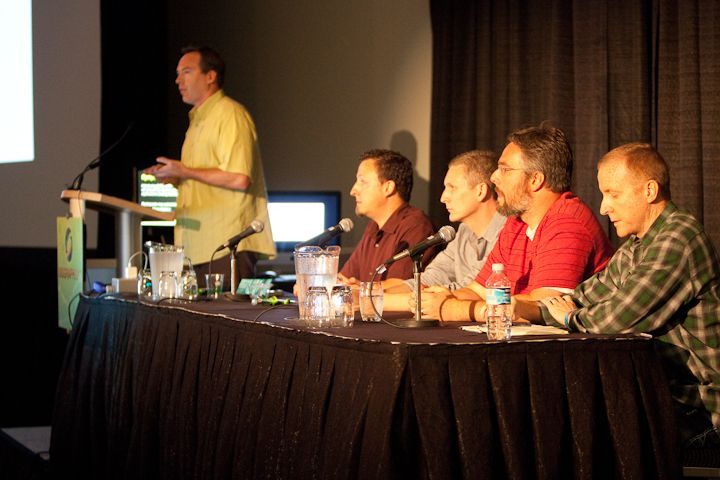Notes from a SIGGRAPH Panel on Successful Creative Collaboration Across Time & Space
What makes collaboration work? Let's hear from Tim McLaughlin (Texas A&M University), Tommy Burnette (Lucasfilm Singapore), Tim Fields (Certain Affinity), Jonathan Gibbs (DreamWorks Animation) and David Parrish (Reel FX Creative Studios).

Participants:
- Tim McLaughlin – Texas A&M University
- Tommy Burnette – Lucasfilm Singapore
- Tim Fields – Certain Affinity
- Jonathan Gibbs – DreamWorks Animation
- David Parrish – Reel FX Creative Studios
People have different communication styles: some do well face to face, others work better remotely – perhaps they are better at written communication, or on webcam.
If we’re in the same room, it’s easier to correct misapprehensions: “splinters become much bigger wounds”. We form tribes, so be careful to make it one tribe instead of us (here) vs them (remote). During time apart, misunderstandings can snowball.
It’s important to have diffusers in the group, reminding people to chill out.
Watch out for “the game of telephone” – you have to be able to talk peer to peer. Not only management talking to each other.
Time zone difference can work very positively – problems solved for you while you sleep. But it’s harder to collaborate as well, and work doesn’t fit neatly into discrete 8-hour chunks. Sometimes there is a specialist – only one person can fix the problem – so if they’re unavailable in an emergency it’s a problem.
Right now our production pipeline has som many restrictions based on how the elements plug in, and you can’t go back up the chain very easily. This inhibits non-linear collaboration.
There is a tension between the creative process and the factory line method for producing work. But the assembly line is efficient when you have a lot of work to do. Efficiency drives the process.
I don’t like the word pipeline; because it doesn’t just flow one way, particularly early in the show. Late in the show things tend to settle down, you don’t need as much collaboration because everyone knows what they’re doing. It’s a piece of the communication issue.
We have groups where everyone is in one place and one person is not, because they’re the right person for the job. When we do that it’s because their creative skill outweighs the difficulty of working with them across distance.
Q. I’m searching for this holy grail online collaboration tool – where does all your stuff live, how do you coordinate all this stuff?
A. As a small factory, communication seems to work OK, asset management is harder.
A. As a large shop, we have entirely custom asset management and it works well; communication is now the problem.
A. When you work with multiple clients, it’s different every time – for every type of collaboration we build a custom tool set. important to document the process.
Especially when focusing on creative work, you have to balance the rules with how the artist wants to work, so you don’t overconstrain that artist – it’s a balancing act. The age-old problem: how do I schedule creativity?
We can’t separate disciplines. Lighting department does rendering, compositing, colour correction etc. Handoff is difficult. You need to keep it alive.
Q. Does distance collaboration make our workplaces friendlier to women and ethnic minorities?
A. Don’t know if it’s better or worse, but it’s an open door.
It’s good for the film industry if films are not all made in California – a wider variety of kinds of people will bring richness to the work. People who choose to live elsewhere can still be part of the process.
In our studio in Singapore, we have more than forty countries represented.
Distant collaboration forces us into greater cultural sensitivity.
So far this is just beginning, but perhaps it is a precursor to a new, more thoroughly distributed future.
At Lucasfilm, we double up on supervisors – make sure there is one at each location so artists can get immediate feedback.
With a properly shared vision, I can give more people the power to make approvals.
Dreamworks: trusted luitenants are important. If something is approved, but then goes up the chain to the Director and back down to be redone, that’s no good. This is part of trust.
Q. Is there a minimum cell size? How independent can cells be?
A. The minimum size is a function of the artist. With some artists, the minimum size is 1. But not everyone works best alone.
A. I’m not going to build a light farm in a location with two guys.
A. But maybe data transfer speed increases will change that.
A. How invested people are in the goals of the company has a big effect – people can be more independent if they’re more invested.
In architecture school, I learned how to give and accept review feedback. We need to figure out how to learn these same skills for remote collaboration.
Cultural differences will always exist – and you want them, they bring different approaches to problems. Everyone needs to feel that it’s “our project”. It’s important to fully uderstand cultural differences.
In some countries “I’m not sure” means “hell no”. Managers need to have some maturity and worldliness.
Universities must make cross-disciplinary groups, and must continue with the dreaded group grade, because that’s the world we all live in. The product succeeds or fails as a whole.
Sometimes you need to have times when you’re all in a room with no time limit, to work until something is creatively resolved. It’s hard (though not impossible) to do that at a distance.
Q. Donna Cox, NCSA: Can you describe any novel proprietary collaborative software you’ve created? Do you collaborate with scientists ever?
Tommy Burnette: We have a close relationship with Stanford, we have students from there who are pretty much on staff.
Tim Fields: In the games business we often hire PhD physicists
Gibbs: We do, but have never worked with people studying this kind of problem – collaboration and communication – scientifically.
Parrish: We have developed software to allow us to hande large feature film projects without requiring a large coordination staff. It allows our supervisors to give feedback to animators, for example, over the web. Animators, modelers and riggers. It tracks our financials, tracks every detail of every project; producers use it to keep on top of budget and make sure artists aren’t working crazy hours.
Gibbs: It is crucial first to have a system that helps you be very clear about what you’re looking at. [sync]
Q: Parrish: Is collaboration making what we do better, or is it just a necessity?
A. Burnette: if it gives us access to talent we wouldn’t otherwise, it makes it better
A: McLaughlin: Being in Texas, it’s made a massive difference. Gives us access to talent, encourages our team to make better tools.
Gibbs: We always want to do more, this is access to more
Fields: We couldn’t do the scale of work we do – 400-man teams – without this.
Q from Blizzard: We have the problem of timing asset deliveries with approvals, and the difficulty of moving back up the chain. How do you deal with this? Is it harder across sites?
A: Burnette: All of our work comes in on time and no-one ever changes their mind.
[laughter]
At some point it becomes more efficient to pay people to keep track of all the information. In smaller teams there isn’t enough overhead to require it, but once you are that big, it’s vital, to manage the information flow across locations and timezones.
The artist who should have been home half an hour ago but stays an extra hour because somethings not good enough yet, is dealing with the same issue as a production manager who wants to make something better but just doesn’t have the money. Better information flows make for better decisions.
As an artist, you always want to make it better – the producer has to make the call to say stop.
[end]
